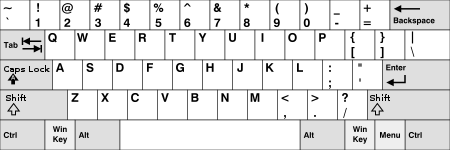| Revision as of 09:36, 22 March 2013 editMelonkelon (talk | contribs)Extended confirmed users, Pending changes reviewers, Rollbackers32,582 editsm WPCleaner v1.26 - fixes← Previous edit | Revision as of 11:25, 26 July 2013 edit undo110.93.232.163 (talk) →BackgroundTag: Visual editNext edit → | ||
| Line 14: | Line 14: | ||
| The delete key, on many modern motherboards, also functions to open the ] setup screen when pressed after starting the computer. | The delete key, on many modern motherboards, also functions to open the ] setup screen when pressed after starting the computer. | ||
| in a simple way delete key is used to delete a character | |||
| ==See also== | ==See also== | ||
Revision as of 11:25, 26 July 2013
Not to be confused with delete character.| This article's lead section may be too short to adequately summarize the key points. Please consider expanding the lead to provide an accessible overview of all important aspects of the article. (August 2012) |

When struck on a computer keyboard during text or command editing, the delete key (Delete or Del, known less ambiguously as forward delete) discards the character ahead of the cursor's position, moving all following characters one position "back" towards the freed letterspace. The key appears on IBM-compatible PC keyboards labeled as Delete or Del. On some Mac keyboards, the key that performs the forward delete function is labeled del, or with a special right arrow glyph enclosing an "x" with the word del or delete above or to the left of it, since the full word delete by itself is reserved for labelling the key known on other keyboards as Backspace.
Background
On Unix-like systems, the delete key is usually mapped to ESC [3 ~ which is the VT220 escape code for the "delete character" key,
On many notebook computer keyboards the key labeled delete (sometimes with backspace printed on the same key) serves the same purpose as a Backspace key. In other cases, the Delete key is in its original IBM notebook position of above and to the right of the Backspace key. Many laptops add rows of smaller keys above the Function key line to add keys on a non-standard size keyboard. On this row of smaller keys, the Delete key is often the third key in from the right. On Apple Inc.'s line of laptops (e.g. the MacBook and MacBook Pro), the forward delete function can be achieved using the Fn+← Backspace key combination.
In some systems the forward delete function can be invoked with Control-H (or, less frequently, Control-?) instead. This is related to ASCII control characters for BS and DEL.
Also, the delete key often works as a generic command to remove a selected object, such as an image embedded in a document (on Macs both the forward delete key and the delete (backspace) key have the same effect when pressed while an object is selected).
The delete key, on many modern motherboards, also functions to open the BIOS setup screen when pressed after starting the computer.
in a simple way delete key is used to delete a character
See also
References
- ^ "Forward Delete (Fwd Del)". Apple Human Interface Guidelines.
- "Image of the keyboard layout of a full-sized aluminum Apple keyboard". Retrieved 2012-07-31.
- "9.8 Keyboard configuration". Debian Policy Manual.
| IBM PC keyboard (Windows, ANSI US layout) | ||||||||||||||||||||||||
|---|---|---|---|---|---|---|---|---|---|---|---|---|---|---|---|---|---|---|---|---|---|---|---|---|
| Esc | F1 | F2 | F3 | F4 | F5 | F6 | F7 | F8 | F9 | F10 | F11 | F12 | PrtScn/ SysRq |
Scroll Lock |
Pause/ Break |
|||||||||
 |
Insert | Home | PgUp | Num Lock |
∕ | ∗ | − | |||||||||||||||||
| Delete | End | PgDn | 7 | 8 | 9 | + | ||||||||||||||||||
| 4 | 5 | 6 | ||||||||||||||||||||||
| ↑ | 1 | 2 | 3 | Enter | ||||||||||||||||||||
| ← | ↓ | → | 0 Ins |
. Del | ||||||||||||||||||||
| Keyboard keys | |
|---|---|
| Dead keys | |
| Modifier keys | |
| Lock keys | |
| Navigation keys | |
| Editing | |
| Contextual | |
| Misc. | |